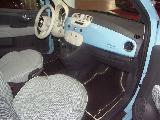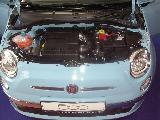|
Retro style rules these times. From the customers point of view there is probably the nostalgy behind, about the old romantic times of the previous century. From the manufacturers point of view, there is a chance, how to sell the technique arranged in interesting style more expensive, than it is possible in the conventional style.


In the case of Fiat 500 we have to confess, that the manufacturer did not go with the over-price so far and this car remained at least little the one, that it used to be. Quite cheap car focused on wide public. Of course, it is more expensive than technically same cars and you pay mainly for the retro and style. But it does not go the way like new Mini or New Beetle, which want much money for their retro. However, we have to say, that they bring the technique of higher classes and the small appearance is only the question of design.
In the Mini case, it is a try to create a new cult car, but also a luxury car, which leaves the original intent of Mini. It was to be a small and thus a cheap car for the mass, who cannot afford bigger. The new Mini is rather a luxury companion and fashion accessory into the rush city. New Beetle has the same goal and what more, it lacks the concept for the future.
Impression
What impression brings a man from the meeting with this car? It is hard to express in words and it is given mainly by the connection of the "look as" cheap car design with the modern technique. Although this car has five star EuroNCAP rating, so the highest possible, it impresses almost like plastic and cheap, but in the good nice sense. The designers did play with it really much and so for example the automatic air-conditioning controls are dressed into "look as" cheap plastic of a simple radio receiver from the 60. of the last century. The same can be said about the digital speed gauge combined with the board computer, which is dressed into the look of a historic value "alarm clock". But as is already written, it still keeps the low price and simple construction. It is seen for example on the photo of the rear axle, which really does not come from Ferrari, but is the simplest possible one.
It is quite complicated to get to the car technical data on the official manufacturer's site. You are watched by a video configuration tool here, by a drink there, or even by a pregnant mom over there. Fiat simply wants to tell us, don't care about the technique, for what the car is it is sufficient, here you have the 500, which do you all long for and enjoy it. So we have decided to look for the technical data on other pages, which offer also technical things. At the exhibition, there was the currently most powerful model, with 1.4 16V 74 kW / 100 HP petrol engine.
Technique
We have got the technical data from the popular database carfolio.com, see the link below, where you can find the specification of almost all ever sold cars.
If someone got to the technical data on the official pages, write the access way into the discussion for this article below, so also the other readers can get oriented.
So shortly. Wheelbase is 2300 mm, length 3546 mm, width 1627 mm, height 1488 mm. With the given engine 1.4 16V 74 kW it has the kerb weight (full fuel tank, but without passengers and luggage) 930 kg. If you add the standardized weight of the driver 68 kg plus the standardized weight of luggage, you get about a ton. And it is not little for such a small vehicle, so the given engine is for vital drive almost necessary in fact, also because of the weak appearance of the Fiat petrol engines. Although the paper values claim about hundred horse power per ton, the practical experience with the petrol Fiat engines is not so attractive. The outside turning diameter is 9.2 m, which offers good maneuverability.
Photogallery
Links
|








































